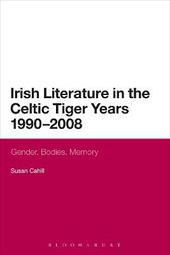
|
Irish Literature in the Celtic Tiger Years 1990 to 2008: Gender, Bodies, Memory
Paperback / softback
Main Details
| Title |
Irish Literature in the Celtic Tiger Years 1990 to 2008: Gender, Bodies, Memory
|
| Authors and Contributors |
By (author) Dr Susan Cahill
|
| Physical Properties |
| Format:Paperback / softback | | Pages:240 |
|
| Category/Genre | Literary studies - fiction, novelists and prose writers |
|---|
| ISBN/Barcode |
9780567533821
|
| Classifications | Dewey:823.91409 |
|---|
| Audience | |
|---|
|
Publishing Details |
| Publisher |
Bloomsbury Publishing PLC
|
| Imprint |
Bloomsbury Academic
|
| Publication Date |
24 October 2013 |
| Publication Country |
United Kingdom
|
Description
When Irish culture and economics underwent rapid changes during the Celtic Tiger Years, Anne Enright, Colum McCann and Eilis Ni Dhuibhne began writing. Now that period of Irish history has closed, this study uncovers how their writing captured that unique historical moment. By showing how Ni Dhuibhne's novels act as considered arguments against attempts to disavow the past, how McCann's protagonists come to terms with their history and how Enright's fiction explores connections and relationships with the female body, Susan Cahill's study pinpoints common concerns for contemporary Irish writers: the relationship between the body, memory and history, between generations, and between past and present. Cahill is able to raise wider questions about Irish culture by looking specifically at how writers engage with the body. In exploring the writers' concern with embodied histories, related questions concerning gender, race, and Irishness are brought to the fore. Such interrogations of corporeality alongside history are imperative, making this a significant contribution to ongoing debates of feminist theory in Irish Studies.
Author Biography
Susan Cahill is Assistant Professor in the School of Canadian Irish Studies, Concordia University, Montreal, Canada.
ReviewsWith the Celtic Tiger well and truly dead, it's time for thepost-mortem to begin, and this book represents a significant contribution tothat process. Susan Cahill's study of a number of important novelists offers anoverview of an extraordinary period in modern Irish history, as well as closeanalyses of some of the most sensitive artistic responses to the island'schanging fortunes. In teasing out the complex interplay between time, memory andthe body, Irish Literature in the Celtic Tiger Years challenges thetheoretical parameters of contemporary Irish cultural criticism, while alsoproviding a compelling vision of the vicissitudes of modern Irish identity. -- Gerry Smyth, Reader in Cultural History, Liverpool John Moores University, USA
|